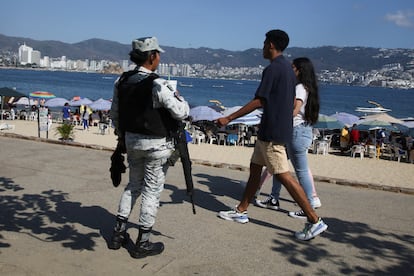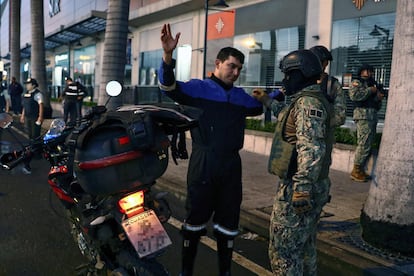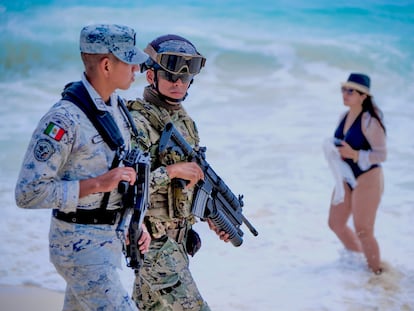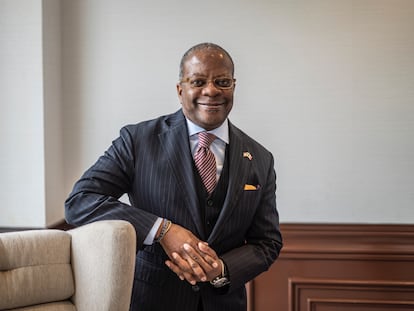From Mexico to Chile: The security crisis consuming Latin America
Violence and organized crime are on the rise across the region, upending government plans and putting citizens on alert


In recent days, two photographs have connected the nearly 4,000 miles (6,300 kilometers) that separate the Mexican state of Quintana Roo and the Chilean city of Santiago. The images are radically different, but they speak of the same thing: a security crisis. In the first photo, soldiers are seen patrolling the beaches of one of Mexico’s most popular tourist spots. From the Caribbean to the Pacific, from Cancun to Acapulco, the goal is the same: to protect visitors during Easter week — a vacation period that began with eight murders in those two destinations. The second image shows the president of Chile, Gabriel Boric, standing with former presidents Sebastián Piñera, Michelle Bachelet and Ricardo Lagos, at the funeral of Daniel Palma, the third police officer to be assassinated in just over three weeks.
An imaginary line can be drawn between the militarization of the Mexican coast and the show of unity from the Chilean political class — one that has very real consequences in everyday life in the region. It crosses Central America, Ecuador, Peru and extends to Colombia and even Argentina. Behind it is organized crime, violence and gangs that exploit migration routes. It’s a security crisis that is hampering government plans and alarming the people of Latin America, who list it as their top concern. In Chile, it is threatening to break apart Boric’s government coalition. Last week, the coalition was divided in Congress on a law that would increase the power of the police — a measure that was eventually approved. Last year was Chile’s most violent in the last decade, with the country recording a homicide rate of 4.6 per 100,000 inhabitants.
That figure is well below the 40.4 registered by Venezuela, but it’s an anomaly that has put the young left-wing president in a difficult situation. The security crisis is compounded by migratory issues — the suspects in the latest police officer murder are Venezuelans. To address the mass arrival of foreigners, the Chilean government has deployed the army on the northern border. “When it comes to fighting crime in the Chilean state, there are no rifts... There is no government and opposition, there is no left or right, there are no old people or young people. We are all united in this crusade,” Boric said last week. According to a regional survey published at the end of February by the Gallup consultancy, 71% of Chileans believe that crime had skyrocketed in the previous four months.

This figure reaches 85% in Ecuador, which, since the beginning of the Covid-19 pandemic three years ago, has seen one of the worst spikes of violence in Latin America due to the rise of criminal gangs. Nearly half the population (48%) says that a member of their household was the victim of a robbery or a mugging between September and December 2022. Exacerbating the crisis is the situation in Guayaquil, the most violent city in Ecuador, where there have been almost 600 murders in less than four months. The political persuasion of the Ecuadorian government is very different to that of Chile’s, and its president, the conservative Guillermo Lasso, has authorized citizens to carry weapons. The controversial measure overthrows a regulation precisely aimed at containing violence: now any Ecuadorian over the age of 25 who passes psycho-technical tests, and other requirements, will be able to have access to a gun.
Although Lasso and Boric are ideological opposites, the two leaders both have suffered in the polls due to the crisis. In Mexico, however, the security crisis has hardly taken any toll on President Andrés López Obrador, who is about to begin his last year in office. The Mexican president radically broke from the security strategy of his predecessors Enrique Peña Nieto and Felipe Calderón and opted for an approach, he called “hugs, not bullets.” This strategy, which was highly criticized by his political adversaries, aimed to reduce violence through comprehensive political action against poverty instead of direct confrontation with organized crime. The plan, nevertheless, has come up against reality. The Mexican government has had to contend with a new cartel war, a substantial spike in migration (and the subsequent rise in gangs that exploit migrants), the fentanyl crisis and increasing pressure from the United States, especially from the most far-right sectors of the Republican Party. According to government figures, homicides fell last year by 7.1%. But the numbers continue to be shocking: 30,968 people were murdered in 2022. As Mexico prepares for the 2024 elections, citizens list insecurity as their top concern.
López Obrador has not been the only president to seek a structural approach to peace. In Colombia — which is still recovering from the more than 50-year-war between the government and the Revolutionary Armed Forces of Colombia (FARC) — President Gustavo Petro has launched a plan for so-called “total peace.” But the initiative is in jeopardy. Talks with the National Liberation Army (ELN) — the oldest active guerrilla in the Americas — remain in limbo after the group attacked a military base two weeks ago, killing nine soldiers. Petro has not been able to hide his anger. “He’s furious,” say those close to the president. Meanwhile, the prospect of a peace deal with the ELN is becoming more and more remote.
For decades, Venezuela has had the highest violence statistics in Latin America. Despite this, people in Venezuela — who are seeing a notable improvement in the economy thanks to the White House’s decision to resume limited oil operations in the country — are not as concerned about security as neighboring countries. Only 35% of Venezuelans believe that crime is on the rise. This is well below the figure in Peru (79%), where — in the wake of Pedro Castillo’s failed self-coup last December — the weakened government has been focusing on cracking down on protests and protecting itself. The perception of insecurity in Venezuela also contrasts to the situation in Costa Rica, which has traditionally been considered an oasis away from the violence. The Central American country, which abolished the army 75 years ago, has seen a 66.5% rise in homicides since 2012.
Violence and organized crime are giving no respite to governments in Latin America. In Brazil, drug traffickers — in particular the organization known as Comando Vermelho — is gaining ground in Rio de Janeiro, and the president of Brazil, Luiz Inácio Lula da Silva, has revived his old public security plan. Argentina is also on alert, with Congress approving a plan to strengthen security in the city of Rosario, where assailants recently opened fire on a supermarket owned by the in-laws of soccer star Lionel Messi.
The only exception is El Salvador, where, according to InSight Crime, “the government’s direct offensive against gangs has caused a drastic reduction in homicide rates, although presumably at the cost of systematic human rights violations.” President Nayib Bukele likes to boast on social media about “zero homicides” or reporting “the safest month.” But the drop in homicides has come at a cost: repression. Organizations such as Human Rights Watch have denounced “flagrant” human rights violations in the country, where Bukele has changed constitutional rules in order to be re-elected.

Sign up for our weekly newsletter to get more English-language news coverage from EL PAÍS USA Edition
Tu suscripción se está usando en otro dispositivo
¿Quieres añadir otro usuario a tu suscripción?
Si continúas leyendo en este dispositivo, no se podrá leer en el otro.
FlechaTu suscripción se está usando en otro dispositivo y solo puedes acceder a EL PAÍS desde un dispositivo a la vez.
Si quieres compartir tu cuenta, cambia tu suscripción a la modalidad Premium, así podrás añadir otro usuario. Cada uno accederá con su propia cuenta de email, lo que os permitirá personalizar vuestra experiencia en EL PAÍS.
¿Tienes una suscripción de empresa? Accede aquí para contratar más cuentas.
En el caso de no saber quién está usando tu cuenta, te recomendamos cambiar tu contraseña aquí.
Si decides continuar compartiendo tu cuenta, este mensaje se mostrará en tu dispositivo y en el de la otra persona que está usando tu cuenta de forma indefinida, afectando a tu experiencia de lectura. Puedes consultar aquí los términos y condiciones de la suscripción digital.
More information
Archived In
Últimas noticias
Welcome to the post-religion era: The idea of Christianity as the absolute truth has become obsolete
‘I thought you would like it’: The risky sexual practice popularized by TV shows and TikTok
The digitalization of tourism: ‘They promise experiences and gave us the worst possible one’
Mexican peso defies uncertainty with forecasts of a new period of stability in 2026
Most viewed
- Sinaloa Cartel war is taking its toll on Los Chapitos
- Oona Chaplin: ‘I told James Cameron that I was living in a treehouse and starting a permaculture project with a friend’
- Reinhard Genzel, Nobel laureate in physics: ‘One-minute videos will never give you the truth’
- Why the price of coffee has skyrocketed: from Brazilian plantations to specialty coffee houses
- Silver prices are going crazy: This is what’s fueling the rally










































